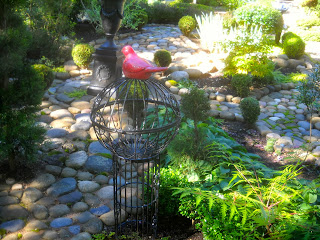 |
| OHIO BUCKEYE FALL LEAF COLOR |
 |
| PAPER BIRCH SEEDS, AS SEEN THROUGH THE MOONROOF OF THE PICKUP TRUCK |
 |
| SUGAR MAPLES ARE COLORING UP |
 |
| PEEK VIEW OF CHEQUAMEGON BAY |
 |
| WHY DID THE TURKEYS CROSS THE ROAD? |
There was no church service at Christ Church Episcopal yesterday because the visiting priest was indisposed, so we had the whole day off to just do whatever. Mostly we drove the countryside in fine early fall weather scouting for grouse. We didn't do much actual hunting because Buddy still has a nasty cough, although he doesn't seem sick in any other way. We immersed ourselves in the growing intensity of fall color, including the rather unlikely, in-town sight of a bronzed Ohio buckeye on Manypenny Avenue. The sugar maples are suddenly coloring up, and to our surprise the paper birch are shedding their seeds, by the untold billions, an event I expect to take place during the winter, when the snow is often littered with the tiny, winged yellow-brown wafers.
We saw a lot of turkeys on our travels, including one huge, bearded Tom that moved off too quickly to snap his photo, but the above flock crossed Hwy. 13 west of the Rez like ducks in a row, and then waited patiently for us to take their picture (I guess that's why they crossed the road).
Our travels took us way out in the boondocks on the very primitive Smith Fire Lane, where we had never ventured before. We drove down it for miles, seeing deer and eagles, but never did get to the end. We walked an offshoot with Buddy, who came to a classic point along the trail. He held it perfectly until the bird finally flushed into the fall foliage. I heard it but never saw it. Darn!
I think the best view of the day was that above, taken from the top of the bluff on Kjarvick Road, looking east over Chequamegon Bay, Upper Peninsula Michigan's Gogebic Range barely a shadow on the horizon.
I have been ruminating, frustrated, over the incongruity of our military installations, first Fort Hood, then last week The Washington Navy Yard, and incidents in-between, being shot up by terrorists and crazies and not being able to shoot back. We are told they have to rely on local police for protection. I suppose there are lots of reasons why this could be the case, but (and I am really not being facetious), doesn't our military have any guns? Or, maybe no bullets? Surely there are Military Police on these bases that should be trained and armed.
If the U.S. Army and Navy are not able to protect themselves, how can we believe they will be able to protect the rest of us? The Obama Administration wants to disarm the American people; has it first managed to disarm its own military? It has, however, armed the Internal Revenue Service to the hilt. What the hell is going on in this country?

























































